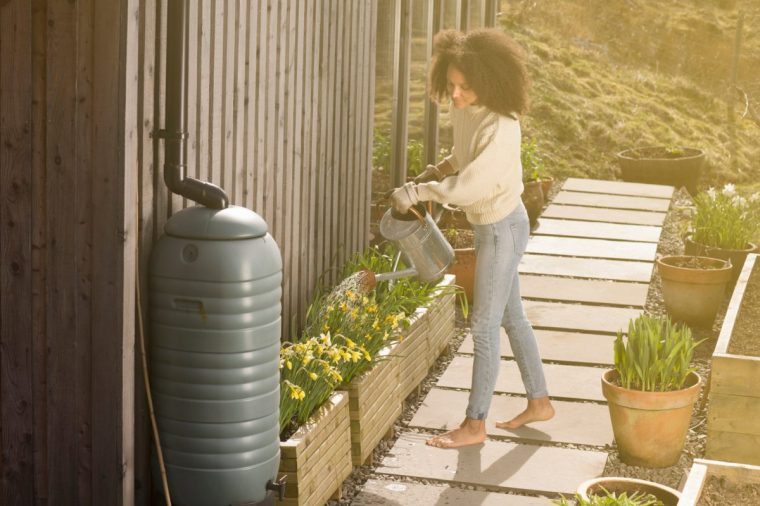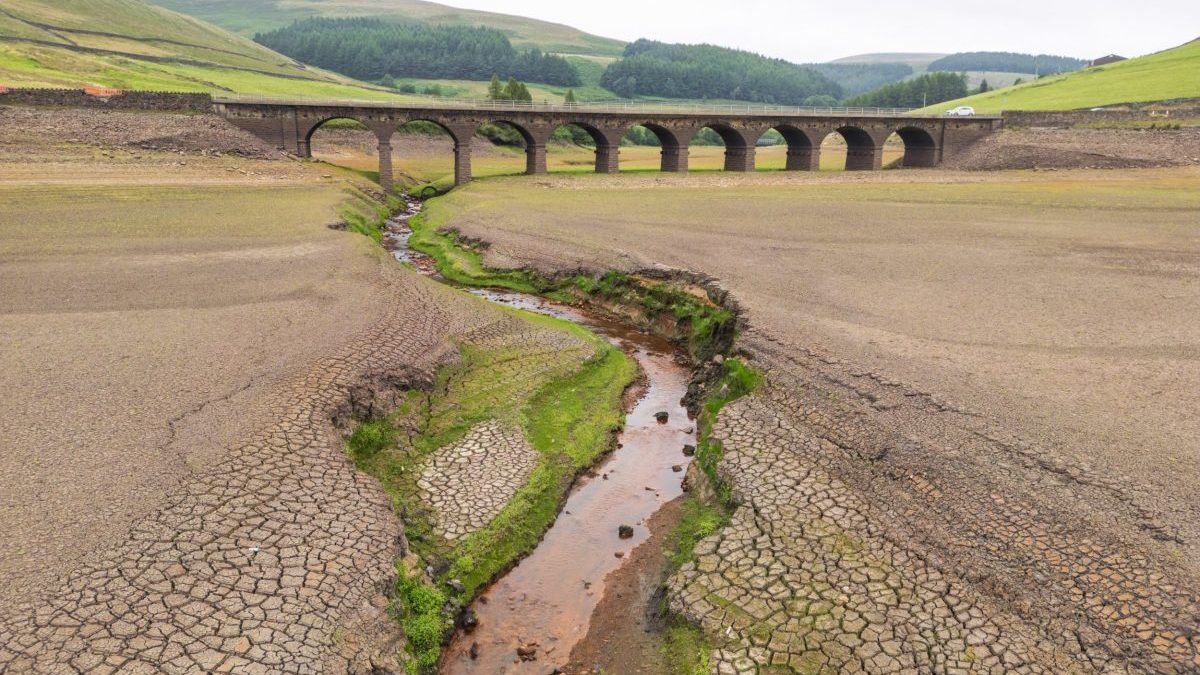13,000 gallons of rain falls on the average UK roof every year, yet unlike other European nations, we don’t use it
“Save water – bath with a friend”: this has to be the most risqué public information advice ever broadcast by the government, but it certainly caught the mood at the height of the 1976 drought. Within days it was on badges and plastered across T-shirts. It might even have saved some water.
As drought conditions intensify across the UK, following the hottest spring on record, and with much of England under a hosepipe ban which is set to continue into autumn, it is time to think again about how we might save water.
It might seem strange that, on an island renowned for its drizzle, we should find ourselves hit once again by water shortages, but this should not really come as a surprise on a planet where global heating is running amok. Six of the hottest years on record in the UK have occurred in the last 10, while three of the hottest summers happened in the last five years. Greater heat drives increased evaporation, and a hotter atmosphere can hold more water vapour, and suck up surface water more rapidly. This can result in so-called flash droughts that can build in a matter of weeks.
Looking ahead, the picture looks pretty grim. Already the South East is designated as suffering from “severe water stress”, and another seven regions could follow as soon as 2030. By mid-century, the prospect of severe drought conditions resulting in water supply to households being cut-off for an extended period is a real one.
Plans for nine new reservoirs – the first for more than 30 years – were recently announced by the Government, but is this really the answer? After decades of gross underinvestment, the privatised water industry is rubbing its hands with glee, because reservoirs appear as assets on their books, and therefore increase the value of the companies. Whether these reservoirs end up being built or not, continuing to ensure that everyone has enough water is going to be a huge challenge in the decades ahead as the heat continues to build. We need to look at other ways of tackling the problem.
Water consumption per head in the UK is amongst the highest in Europe, while at the same time the equivalent of more than 1,200 Olympic-sized swimming pools of water is lost through leaks every day. Clearly, there is a huge amount of slack to be taken up before spending billions on new reservoirs. There is also plenty we can do ourselves, both to cut usage, and to provide us with some peace of mind if and when the supply is cut off.
 Rainwater harvesting saves water and reduces the risk of flooding (Photo: Leon Harris Getty Images)
Rainwater harvesting saves water and reduces the risk of flooding (Photo: Leon Harris Getty Images)
When it comes to saving water Britain is far behind Europe, where both heat and drought have been building more rapidly in recent years. One of the solutions being embraced here, to handle water shortages, is what is called rainwater harvesting. Germany is ahead of the field at the moment, with almost two million homes having facilities to intercept and store rainwater. This is then used mainly for outdoor washing tasks, so that reliance on a centralised drinking water supply is reduced by the equivalent of around 50,000 Olympic swimming pools every year.
At the same time, there is the added bonus that less water flowing into storm drains during downpours also acts to reduce the risk of flooding. This has not all happened by accident, but is a consequence of tax breaks and subsidies from the German government, and it’s an approach being followed by other European countries too, including Belgium, France and Switzerland.
It makes sense in the UK too, where winter rainfall – which is actually increasing – can be stored for the hotter months, alongside intercepted thundery downpours that are already a common feature of our summers. Given that something like 13,000 gallons of rain falls on the average UK roof every year – more than one third of the average water usage for a four-person household – it seems daft not to intercept it.
Buying a harvesting system that links seamlessly with a mains supply is expensive, but purchasing the kit for linking gutters to water butts is cheap and easy to install. With almost an acre of land, on which we grow more than 30 varieties of fruit and veg, rainwater harvesting is absolutely essential for us. But it actually makes sense for everyone. The intercepted rainfall can be used for watering the garden – which plants prefer anyway – cleaning the car along with patios and driveways, washings windows and floors and, if you wish, flushing the loo.
When you think about it, using drinking water for all these activities seems more than a little bit bonkers. Drinking rainwater, even after it has been boiled, is not safe, due to contaminants picked up in the atmosphere and while stored, but you can buy filtering systems that make it potable.
Rainwater harvesting is worthwhile because it provides some degree of self-sufficiency, but the key takeaway here is that if millions of households harvest rainwater and use it for as many tasks as possible, then demand for increasingly precious mains drinking water can be massively reduced, allowing it to go further and cutting the chances of stand-pipes in the street during future droughts that are only going to get worse.
In the UK, some local councils and water utilities provide grants or rebates to cover part of the cost of installing rainwater harvesting equipment, and businesses may qualify for help with the cost of installation in the form of tax credits. At the moment, however, there is no national rainwater management strategy, little available public information on the subject, and no serious incentives for households or businesses to intercept and reuse rain. This has to change.
Before water users are forced to cough up billions in higher bills to pay for new reservoirs, the government must incentivise rainwater harvesting at a level that drives a big take-up. At the same time, it needs to force water companies to do far more to prevent the leaks that mean colossal volumes of water are lost every year. Not to do this makes no sense at all.
As long as we keep pumping out carbon dioxide, our climate – both in the UK and across the world – is going to get hotter, and water is going to become ever more scarce. Future droughts, driven by 40°C-plus heatwaves, will make this summer and that of 1976 seem cool and damp in comparison. Severe water shortages are now inevitable, and if we don’t get our act together now, in order to make the most of the water that falls out of the skies, we are going to be in deep trouble.
Measures we take today will bear fruit in the decades ahead. If we do nothing, then we will all eventually have to resign ourselves to hours queuing in the street for water. Meanwhile, bathing with a friend is definitely out, but I am sure a quick shared shower would be absolutely fine.
Bill McGuire is professor emeritus of geophysical and climate hazards at UCL. His next book – ‘The Fate of the World: a Deep-time History of the Climate Crisis’ – is out next year.
Six easy ways to save water at home
- Only if we can see how much we are using can we seriously cut back, so getting a water meter installed is a no-brainer in terms of reducing demand, especially as it will save you money as well.
- Using the “eco” settings on your dishwasher and washing machine can save 40 litres of water a day. Baths use huge amounts of water – swapping one weekly bath for a shower can save you around 4,000 litres of water annually. Having shorter showers at around 5-7 minutes also reduces water use. If you want to go further, you can now buy water saving taps, showers and toilets.
- Turn off the tap whilst brushing your teeth – this can save a typical household 9,000 litres of water a year according to Water UK.
- Fill your kettle less. Only fill it with the water you need and do not replace the water before every boil. A 10 per cent reduction in kettle water use can save 3.65 gallons of water a year.
- Do less washing up. Leaving most washing up until the end of the day can reduce frequently running your tap water – as can putting as much as possible in the dishwasher.
- Avoid half-full washing loads. Only filling your washing machine halfway uses more than 50 per cent the energy and water of a full load. Washing machines use on average 60 litres of water per cycle so running them less frequently can save water.
